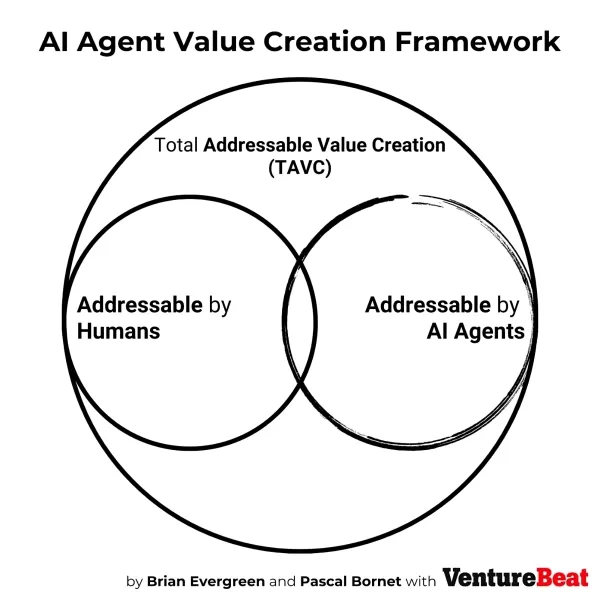From AI Hype to Practicality: Enterprises Must Prioritize Fit Over Flash
As we dive deeper into the era of autonomous transformation, AI agents are reshaping how businesses function and generate value. But with a sea of vendors touting their "AI agents," it's tough to sift through the noise and pinpoint what these systems can really do—and, crucially, how we should be using them.
It's not as simple as listing tasks for automation and testing AI agents against benchmarks. Just like choosing a jet for a quick trip to the grocery store would be overkill, we need to think more critically about how we integrate AI into our work.
Why We Shouldn't Be Trying to Replace Our Work with AI Agents
Every organization strives to deliver value to its customers, partners, and employees. This value is only a slice of what the organization could potentially create, given the demands and desires of those it serves.
When employees end their day with a list of tasks for tomorrow and another list of tasks they had to deprioritize—tasks that could have added value if they had been addressed—it's clear there's a gap between potential and actual value creation. This leaves untapped value on the table.
The obvious starting point for implementing AI agents is to look at the existing work and the value it produces. It's easy to see the immediate benefits: automating tasks to do them faster or more reliably. While this approach is valid as part of a transformation strategy, the pitfall many organizations fall into is focusing solely on enhancing the value they're already creating. This limits their vision and investments to a small segment of their potential, as shown in the Venn diagram below, leaving much of the addressable value untouched.
Humans and machines have unique strengths and weaknesses. Companies that collaborate to redesign their workflows with their business, technology, and industry partners will outperform those fixated on automating existing value without expanding their total value output.

Understanding AI Agent Capabilities through the SPAR Framework
To demystify how AI agents function, we've developed the SPAR framework: sense, plan, act, and reflect. This model echoes the way humans pursue goals and offers a straightforward lens to view AI agent operations.
Sensing
Just as we use our senses to understand our surroundings, AI agents gather data from their environment. They detect triggers, collect pertinent information, and keep tabs on their operational context.
Planning
After sensing, AI agents don't rush into action. Similar to humans weighing their options, these agents analyze the data in light of their objectives and constraints to make strategic decisions on how to achieve their goals.
Acting
The ability to execute actions distinguishes AI agents from mere analytical tools. They can orchestrate various tools and systems to perform tasks, monitor their progress in real-time, and adjust as needed to stay on track.
Reflecting
Arguably the most advanced feature is the capacity to learn from experience. Sophisticated AI agents can assess their performance, scrutinize results, and refine their methods based on what proves effective, fostering a cycle of continuous improvement.
The power of AI agents lies in the seamless integration of these four capabilities, enabling them to tackle complex objectives with growing finesse. This approach contrasts with existing, often optimized, processes where incremental improvements may yield limited gains. Exploring new avenues for value creation and market development can lead to exponential growth.
5 Steps to Build Your AI Agent Strategy
The traditional method for introducing AI, which many technologists, consultants, and business leaders follow, has an 87% failure rate:
- List out problems to solve;
- Or:
- Examine your data;
- Select potential use cases;
- Evaluate use cases for ROI, feasibility, cost, and timeline;
- Choose a subset of use cases and invest in their execution.
This method might seem sound, as it's widely accepted as best practice, but the evidence suggests it's not effective. It's time for a new strategy:
- Map out the total potential value your organization could deliver to customers and partners, considering your core competencies and the market's regulatory and geopolitical landscape.
- Assess your organization's current value creation.
- Identify the top five opportunities that could create new, significant value and potentially open new markets.
- Evaluate these opportunities for ROI, feasibility, cost, and timeline to develop AI agent solutions (repeat steps 3 and 4 as needed).
- Select a subset of value cases and commit to their execution.
Creating New Value with AI
Embarking on the journey into autonomous transformation isn't a race—it's a strategic evolution, where organizational capabilities grow in tandem with technological advancements. By starting with a clear understanding of value and methodically expanding ambitions, your organization can flourish in the age of AI agents.
Brian Evergreen is the author of Autonomous Transformation: Creating a More Human Future in the Era of Artificial Intelligence
Pascal Bornet is the author of Agentic Artificial Intelligence: Harnessing AI Agents to Reinvent Business, Work and Life
Evergreen and Bornet, along with Cassie Kozyrkov, are offering a new online course on AI agents: Agentic Artificial Intelligence for Leaders
Related article
 Manus Debuts 'Wide Research' AI Tool with 100+ Agents for Web Scraping
Chinese AI innovator Manus, which previously gained attention for its pioneering multi-agent orchestration platform catering to both consumers and professional users, has unveiled a groundbreaking application of its technology that challenges convent
Manus Debuts 'Wide Research' AI Tool with 100+ Agents for Web Scraping
Chinese AI innovator Manus, which previously gained attention for its pioneering multi-agent orchestration platform catering to both consumers and professional users, has unveiled a groundbreaking application of its technology that challenges convent
 Top AI Labs Warn Humanity Is Losing Grasp on Understanding AI Systems
In an unprecedented show of unity, researchers from OpenAI, Google DeepMind, Anthropic and Meta have set aside competitive differences to issue a collective warning about responsible AI development. Over 40 leading scientists from these typically riv
Top AI Labs Warn Humanity Is Losing Grasp on Understanding AI Systems
In an unprecedented show of unity, researchers from OpenAI, Google DeepMind, Anthropic and Meta have set aside competitive differences to issue a collective warning about responsible AI development. Over 40 leading scientists from these typically riv
 Anthropic's AI Upgrade: Claude Now Searches Entire Google Workspace Instantly
Today's major upgrade from Anthropic transforms Claude from an AI assistant into what the company calls a "true virtual collaborator," introducing groundbreaking autonomous research capabilities and seamless Google Workspace integration. These advanc
Comments (3)
0/200
Anthropic's AI Upgrade: Claude Now Searches Entire Google Workspace Instantly
Today's major upgrade from Anthropic transforms Claude from an AI assistant into what the company calls a "true virtual collaborator," introducing groundbreaking autonomous research capabilities and seamless Google Workspace integration. These advanc
Comments (3)
0/200
![WillieJackson]() WillieJackson
WillieJackson
 September 13, 2025 at 8:30:51 AM EDT
September 13, 2025 at 8:30:51 AM EDT
Finalmente alguien habla claro sobre el exceso de marketing en IA. Las empresas deberían enfocarse en soluciones prácticas en lugar de perseguir modas tecnológicas. ¿Cuántos 'agentes de IA' prometidos terminan siendo simples chatbots con otro nombre? 🤷♂️


 0
0
![JerryLee]() JerryLee
JerryLee
 August 27, 2025 at 8:59:25 AM EDT
August 27, 2025 at 8:59:25 AM EDT
This article nails it! Too many companies are chasing shiny AI buzzwords without checking if the tech actually fits their needs. It's like buying a sports car for a farm—cool, but useless. Focus on practical use cases, people! 😎


 0
0
![PaulSanchez]() PaulSanchez
PaulSanchez
 August 25, 2025 at 9:01:18 PM EDT
August 25, 2025 at 9:01:18 PM EDT
This article nails it! Too many companies are chasing shiny AI buzzwords without checking if it actually fits their needs. It's like buying a sports car for a grocery run—cool, but overkill. 😅 Curious to see how enterprises will balance hype vs. real-world use.


 0
0
As we dive deeper into the era of autonomous transformation, AI agents are reshaping how businesses function and generate value. But with a sea of vendors touting their "AI agents," it's tough to sift through the noise and pinpoint what these systems can really do—and, crucially, how we should be using them.
It's not as simple as listing tasks for automation and testing AI agents against benchmarks. Just like choosing a jet for a quick trip to the grocery store would be overkill, we need to think more critically about how we integrate AI into our work.
Why We Shouldn't Be Trying to Replace Our Work with AI Agents
Every organization strives to deliver value to its customers, partners, and employees. This value is only a slice of what the organization could potentially create, given the demands and desires of those it serves.
When employees end their day with a list of tasks for tomorrow and another list of tasks they had to deprioritize—tasks that could have added value if they had been addressed—it's clear there's a gap between potential and actual value creation. This leaves untapped value on the table.
The obvious starting point for implementing AI agents is to look at the existing work and the value it produces. It's easy to see the immediate benefits: automating tasks to do them faster or more reliably. While this approach is valid as part of a transformation strategy, the pitfall many organizations fall into is focusing solely on enhancing the value they're already creating. This limits their vision and investments to a small segment of their potential, as shown in the Venn diagram below, leaving much of the addressable value untouched.
Humans and machines have unique strengths and weaknesses. Companies that collaborate to redesign their workflows with their business, technology, and industry partners will outperform those fixated on automating existing value without expanding their total value output.

Understanding AI Agent Capabilities through the SPAR Framework
To demystify how AI agents function, we've developed the SPAR framework: sense, plan, act, and reflect. This model echoes the way humans pursue goals and offers a straightforward lens to view AI agent operations.
Sensing
Just as we use our senses to understand our surroundings, AI agents gather data from their environment. They detect triggers, collect pertinent information, and keep tabs on their operational context.
Planning
After sensing, AI agents don't rush into action. Similar to humans weighing their options, these agents analyze the data in light of their objectives and constraints to make strategic decisions on how to achieve their goals.
Acting
The ability to execute actions distinguishes AI agents from mere analytical tools. They can orchestrate various tools and systems to perform tasks, monitor their progress in real-time, and adjust as needed to stay on track.
Reflecting
Arguably the most advanced feature is the capacity to learn from experience. Sophisticated AI agents can assess their performance, scrutinize results, and refine their methods based on what proves effective, fostering a cycle of continuous improvement.
The power of AI agents lies in the seamless integration of these four capabilities, enabling them to tackle complex objectives with growing finesse. This approach contrasts with existing, often optimized, processes where incremental improvements may yield limited gains. Exploring new avenues for value creation and market development can lead to exponential growth.
5 Steps to Build Your AI Agent Strategy
The traditional method for introducing AI, which many technologists, consultants, and business leaders follow, has an 87% failure rate:
- List out problems to solve;
- Or:
- Examine your data;
- Select potential use cases;
- Evaluate use cases for ROI, feasibility, cost, and timeline;
- Choose a subset of use cases and invest in their execution.
This method might seem sound, as it's widely accepted as best practice, but the evidence suggests it's not effective. It's time for a new strategy:
- Map out the total potential value your organization could deliver to customers and partners, considering your core competencies and the market's regulatory and geopolitical landscape.
- Assess your organization's current value creation.
- Identify the top five opportunities that could create new, significant value and potentially open new markets.
- Evaluate these opportunities for ROI, feasibility, cost, and timeline to develop AI agent solutions (repeat steps 3 and 4 as needed).
- Select a subset of value cases and commit to their execution.
Creating New Value with AI
Embarking on the journey into autonomous transformation isn't a race—it's a strategic evolution, where organizational capabilities grow in tandem with technological advancements. By starting with a clear understanding of value and methodically expanding ambitions, your organization can flourish in the age of AI agents.
Brian Evergreen is the author of Autonomous Transformation: Creating a More Human Future in the Era of Artificial Intelligence
Pascal Bornet is the author of Agentic Artificial Intelligence: Harnessing AI Agents to Reinvent Business, Work and Life
Evergreen and Bornet, along with Cassie Kozyrkov, are offering a new online course on AI agents: Agentic Artificial Intelligence for Leaders
 Manus Debuts 'Wide Research' AI Tool with 100+ Agents for Web Scraping
Chinese AI innovator Manus, which previously gained attention for its pioneering multi-agent orchestration platform catering to both consumers and professional users, has unveiled a groundbreaking application of its technology that challenges convent
Manus Debuts 'Wide Research' AI Tool with 100+ Agents for Web Scraping
Chinese AI innovator Manus, which previously gained attention for its pioneering multi-agent orchestration platform catering to both consumers and professional users, has unveiled a groundbreaking application of its technology that challenges convent
 Top AI Labs Warn Humanity Is Losing Grasp on Understanding AI Systems
In an unprecedented show of unity, researchers from OpenAI, Google DeepMind, Anthropic and Meta have set aside competitive differences to issue a collective warning about responsible AI development. Over 40 leading scientists from these typically riv
Top AI Labs Warn Humanity Is Losing Grasp on Understanding AI Systems
In an unprecedented show of unity, researchers from OpenAI, Google DeepMind, Anthropic and Meta have set aside competitive differences to issue a collective warning about responsible AI development. Over 40 leading scientists from these typically riv
 Anthropic's AI Upgrade: Claude Now Searches Entire Google Workspace Instantly
Today's major upgrade from Anthropic transforms Claude from an AI assistant into what the company calls a "true virtual collaborator," introducing groundbreaking autonomous research capabilities and seamless Google Workspace integration. These advanc
Anthropic's AI Upgrade: Claude Now Searches Entire Google Workspace Instantly
Today's major upgrade from Anthropic transforms Claude from an AI assistant into what the company calls a "true virtual collaborator," introducing groundbreaking autonomous research capabilities and seamless Google Workspace integration. These advanc
 September 13, 2025 at 8:30:51 AM EDT
September 13, 2025 at 8:30:51 AM EDT
Finalmente alguien habla claro sobre el exceso de marketing en IA. Las empresas deberían enfocarse en soluciones prácticas en lugar de perseguir modas tecnológicas. ¿Cuántos 'agentes de IA' prometidos terminan siendo simples chatbots con otro nombre? 🤷♂️


 0
0
 August 27, 2025 at 8:59:25 AM EDT
August 27, 2025 at 8:59:25 AM EDT
This article nails it! Too many companies are chasing shiny AI buzzwords without checking if the tech actually fits their needs. It's like buying a sports car for a farm—cool, but useless. Focus on practical use cases, people! 😎


 0
0
 August 25, 2025 at 9:01:18 PM EDT
August 25, 2025 at 9:01:18 PM EDT
This article nails it! Too many companies are chasing shiny AI buzzwords without checking if it actually fits their needs. It's like buying a sports car for a grocery run—cool, but overkill. 😅 Curious to see how enterprises will balance hype vs. real-world use.


 0
0





























